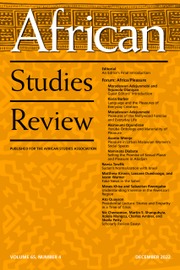The book cover of African Women Writing Diaspora: Transnational Perspectives in the Twenty-First Century presents a powerful visual metaphor by integrating a black woman’s profile with an urban skyline. The design skillfully symbolizes the intersection of homeland memories and new diasporic experiences, with the cityscape emerging from the woman’s head representing this duality. The smiling portrait’s expression conveys optimism, a thoughtfulness that aligns with the book’s intellectual focus.
This collection examines African migrants’ experiences as they face racism, economic hardship, and cultural alienation abroad, which exposes the stark contrast between expectations and reality. Sackeyfio’s introduction masterfully sets the stage by tracing the evolution of African women’s writing from pioneering authors to contemporary voices with themes of globalization, migration, and transnational identities. She demonstrates how female authors have progressed from marginal positions to claim significant space in the African literary canon.
In Chapter One, “Memory, Identity, and Return,” Sackeyfio analyzes how Yaa Gyasi’s Homegoing interweaves themes of memory and identity through multiple generations of Ghanaian women and their descendants. The analysis particularly illuminates the novel’s cyclical structure and return to Cape Coast, which is incredibly insightful, showing how physical spaces serve as anchors for historical trauma and potential healing. Sackeyfio examines how memory haunts female characters across generations in the diaspora, which could provide a compelling entry point for analyzing intergenerational trauma transmission.
In the second chapter, “Malian Immigration in France: Perspectives from African Women Writers of French Expression,” Cheryl Toman focuses on Malian immigrant experiences in France by comparing texts written twenty-three years apart, revealing changes and continuities in immigrant experiences. These narratives serve as historical documents and social critiques for marginalized voices, exploring intersections of gender, cultural displacement, and discrimination. The chapter effectively analyses Beyala’s fictional approach and Diallo’s autobiography while providing a strong historical context. However, it could benefit from an analysis of current French immigration policies’ impact on Malian women and a deeper examination of using Franco-Cameroonian Beyala’s outsider perspective to represent Malian experiences by addressing the potential limitations.
In Chapter Three, “Waithood and Girlhood in NoViolet Bulawayo’s We Need New Names,” Amanda Lagji explores the concept of waithood. By examining the suspended development and liminal identities of young migrants, Lagji reveals a poignant generational dynamic of waiting that transcends individual experiences. The analysis highlights a profound reversal of expectation where children are made to wait in their home countries, only to have their parents subsequently wait for their children to return home, effectively challenging traditional Bildungsroman conventions. Her analysis connects character experiences to broader political critiques of colonial and postcolonial migration histories.
Chapter Four, written by Tomi Adeaga and titled “Sexuality, Resilience, and Mobility in Amma Darko’s Beyond the Horizon and Chika Unigwe’s On Black Sisters’ Street”—an analysis of sex-trafficking narratives in Amma Darko’s and Chika Unigwe’s works—provides crucial insight into the darker aspects of African women’s global mobility under forced migration. By analyzing Darko’s linear narrative and Unigwe’s polyphonic approach, she reveals diverse storytelling techniques that expose systemic exploitation. The study illuminates the complex dynamics of trafficking, ranging from individual psychological trauma to collective resistance and solidarity.
Nancy Henaku analyzes in Chapter Five, “Transnational African Women as Voices of Conscience,” how three contemporary novels, Aidoo’s Our Sister Killjoy, Adichie’s Americanah, and Atta’s A Bit of Difference, reshape transnational feminist discourse through intersections of mobility, voice, and consciousness. She effectively traces the evolution from Third World Feminism to Transnational Feminism while redefining mobility beyond geographic movement, to show how African women authors challenge nationalist and imperial narratives. Henaku demonstrates how mobility functions as a narrative device and analytical framework.
In Chapter Six, “Local and Global Perspectives on Nigerian Women’s Activism,” Sackeyfio’s analysis of Sefi Atta’s News from Home examines how contemporary writers bridge local and global feminist consciousness through Nigerian women’s activism. Using an ecofeminist lens, she explores environmental devastation in the Niger Delta, demonstrating its disproportionate impact on women. The chapter effectively combines empirical evidence, including Anugwom’s research on socioeconomic deprivation, with personal narratives to strengthen its arguments. While the analysis excels at documenting problems and impacts, it could have explored successful resistance strategies and positive outcomes from women’s activism more thoroughly.
Chapter Seven, “Breaking Mythical Barriers through Feminist Engagement with Magical Realism,” offers a fresh perspective on how Nnedi Okorafor’s work revolutionizes the traditionally male-dominated realm of African magical realism through a feminist lens, using speculative fiction to challenge gender boundaries. Elijah Adeoluwa Olusegun examines her unique blend of Western and African literary traditions to create Afrofuturistic storytelling that challenges gender norms and cultural barriers. Through detailed analysis of protagonists Sunny and Onyesonwu, Olusegun demonstrates how Okorafor’s characters navigate physical and spiritual worlds. However, the chapter could have better connected these characters’ experiences to real-world challenges faced by African women to strengthen its argument about the social impact of Okorafor’s work.
Sackeyfio’s conclusion, “Shifting the Boundaries of African Women’s Writing,” expertly examines how contemporary African women writers reshape African literature through diaspora narratives and transnational experiences. She critically analyzes the concept of Afropolitanism, which she treats with appreciation and skepticism. This scholarly collection draws strength from its diverse perspectives, bringing together varied cultural viewpoints to analyze how contemporary African women writers approach themes of displacement, marginalization, and identity formation.


